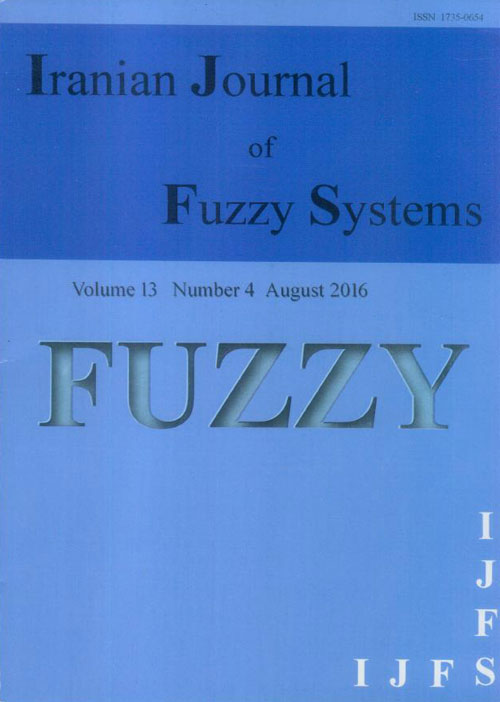فهرست مطالب

Iranian journal of fuzzy systems
Volume:13 Issue: 4, Aug - Sep 2016
- 158 صفحه،
- تاریخ انتشار: 1395/06/27
- تعداد عناوین: 9
-
-
Pages 1-16In this paper, we investigate the multiple attribute decision making (MADM) problem based on the arithmetic and geometric aggregation operators with hesitant fuzzy linguistic information. Then, motivated by the idea of traditional arithmetic operation, we have developed some aggregation operators for aggregating hesitant fuzzy linguistic information: hesitant fuzzy linguistic weighted average (HFLWA) operator, hesitant fuzzy linguistic ordered weighted average (HFLOWA) operator and hesitant fuzzy linguistic hybrid average (HFLHA) operator. Furthermore, we propose the concept of the dual hesitant fuzzy linguistic set and develop some aggregation operators with dual hesitant fuzzy linguistic information. Then, we have utilized these operators to develop some approaches to solve the hesitant fuzzy linguistic multiple attribute decision making problems. Finally, a practical example is given to verify the developed approach and to demonstrate its practicality and effectiveness.Keywords: Multiple attribute decision making (MADM), Hesitant fuzzy linguistic values, Hesitant fuzzy linguistic hybrid average (HFLHA) operator, Dual hesitant fuzzy linguistic set
-
Pages 17-33The multiobjective two person matrix game problem with fuzzy payoffs is considered in this paper. It is assumed that fuzzy payoffs are triangular fuzzy numbers. The problem is converted to several multiobjective matrix game problems with interval payoffs by using the $alpha$-cuts of fuzzy payoffs. By solving these problems some $alpha$-Pareto optimal strategies with some interval outcomes are obtained. An interactive algorithm is presented to obtain a satisfactory strategy of players. Validity and applicability of the method is illustrated by a practical example.Keywords: Fuzzy multiobjective game, Interval multiobjective programming, Satisfactory strategy, Security level
-
Pages 35-50In this note, we define bisimulation for BL-general fuzzy automata and show that if there is a bisimulation between two BL-general fuzzy automata, then they have the same behavior.
For a given BL-general fuzzy automata, we obtain the greatest bisimulation for the BL-general fuzzy automata. Thereafter, if we use the greatest bisimulation, then we obtain a quotient BL-general fuzzy automata and this quotient is minimal, furthermore there is a morphism from the first one to its quotient.
Also, for two given BL-general fuzzy automata we present an algorithm, which determines bisimulation between them.
Finally, we present some examples to clarify these new notions.Keywords: BL, general fuzzy automata, Bisimulation, Reduction, General fuzzy automata, Quotient automata -
Pages 51-61In this paper, the concepts of $L$-concave structures, concave $L$-interior operators and concave $L$-neighborhood systems are introduced. It is shown that the category of $L$-concave spaces and the category of concave $L$-interior spaces are isomorphic, and they are both isomorphic to the category of concave $L$-neighborhood systems whenever $L$ is a completely distributive lattice. Also, it is proved that these categories are all isomorphic to the category of $L$-convex spaces whenever $L$ is a completely distributive lattice with an order-reversing involution operator.Keywords: $L$, convex structure, $L$, concave structure, Convex $L$, closure operator, Concave $L$, interior operator, Concave $L$, neighborhood system
-
Pages 63-78A novel approach to the problem of regression modeling for fuzzy input-output data is introduced.
In order to estimate the parameters of the model, a distance on the space of interval-valued quantities is employed.
By minimizing the sum of squared errors, a class of regression models is derived based on the interval-valued data obtained from the $alpha$-level sets of fuzzy input-output data.
Then, by integrating the obtained parameters of the interval-valued regression models, the optimal values of parameters for the main fuzzy regression model are estimated.
Numerical examples and comparison studies are given to clarify the proposed procedure, and to show the performance of the proposed procedure with respect to some common methods.Keywords: Fuzzy regression, Interval, valued regression, Least squares method, $LR$, Fuzzy number, Multiple regression, Predictive ability -
Pages 79-94In this paper, we prove the existence and uniqueness of solution to the impulsive fuzzy functional differential equations under generalized Hukuhara differentiability via the principle of contraction mappings. Some examples are provided to illustrate the result.Keywords: Impulsive fuzzy functional differential equations, impulsive functional differential equations, impulsive differential equations
-
Pages 95-111This paper presents the concepts of $(L,M)$-fuzzy Q-convergence spaces and stratified $(L,M)$-fuzzy Q-convergence spaces. It is shown that the category of stratified $(L,M)$-fuzzy Q-convergence spaces is a bireflective subcategory of the category of $(L,M)$-fuzzy Q-convergence spaces, and the former is a Cartesian-closed topological category. Also, it is proved that the category of stratified $(L,M)$-fuzzy topological spaces can be embedded in the category of stratified $(L,M)$-fuzzy Q-convergence spaces as a reflective subcategory, and the former is isomorphic to the category of topological stratified $(L,M)$-fuzzy Q-convergence spaces.Keywords: (Stratified) $(L, M)$, fuzzy topology, M)$, fuzzy Q, convergence structure, Topological category, Cartesian, closedness
-
Pages 113-123In the current paper, consider the fuzzy normed linear space $(X,N)$ which is defined by Bag and Samanta. First, we construct a new fuzzy topology on this space and show that these spaces are Hausdorff locally convex fuzzy topological vector space. Some necessary and sufficient conditions are established to illustrate that the presented fuzzy topology is equivalent to two previously studied fuzzy topologies.Keywords: Fuzzy norm, Fuzzy topology, locally convex topological vector space
-
Pages 125-144This paper extends the notion of fuzzy $BCK$-subalgebras to fuzzy hyper $BCK$-subalgebras and defines an extended fuzzy $BCK$-subalgebras. This study considers a type of fuzzy hyper $BCK$-ideals in this hyperstructure and describes the relationship between hyper $BCK$-ideals and fuzzy hyper $BCK$-ideals. In fact, it tries to introduce a strongly regular relation on hyper $BCK$-algebras. Moreover, by using the fuzzy hyper $BCK$-ideals, it defines a congruence relation on (weak commutative) hyper $BCK$-algebras that under some conditions is strongly regular and the quotient of any hyper $BCK$-algebra via this relation is a $($hyper $BCK$-algebra$)$ $BCK$-algebra.Keywords: Extended fuzzy $BCK$, subalgebra, (Strongly) Fuzzy hyper $BCK$, ideal, Fundamental relation $beta^*$

